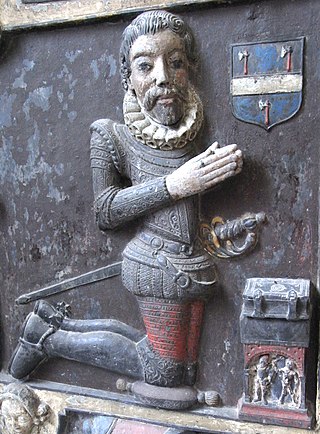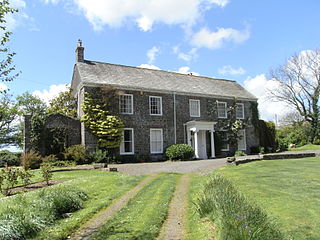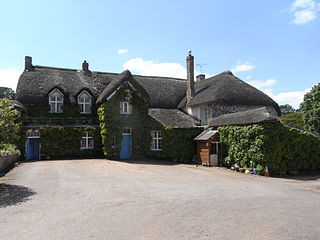


Painsford (anciently Pinford, [1] etc.) is an historic estate in the parish of Ashprington in Devon.



Painsford (anciently Pinford, [1] etc.) is an historic estate in the parish of Ashprington in Devon.
Painsford House was described as follows in 1850: "It was formerly much larger than at present, and its dilapidated chapel, though disused since the middle of the last century" (i.e. the 18th century), "still retains its pulpit, pews and altar -piece, and has a suit of armour hanging over the communion rails. The left wing of the house has a fine row of arches." [2] In 2017 Painsford is a farmhouse much reduced in size displaying few signs of its former high status as a mansion of the Devonshire gentry. It is of an "L-shape" with rendered facade facing the garden. Ruins of the west wing survive, namely of a loggia with octagonal piers. Only the south and west walls survive of the chapel refounded by John Kellond in 1687. [3]
The estate is not mentioned in the Domesday Book of 1086. The earliest holder recorded by Pole (died 1635) was John Wolhey, who was seated there during the reign of King Edward III (1327–1377).

Richard Piperell held Painsford during the reign of King Richard II (1377–1399). He was succeeded by his son Richard Piperell (died 1406/07) [5] who died without progeny, when his heir became his sister Alis Piperell, then aged 40, the wife of her near neighbour Walter Halgewell (alias Halgawell) of Halgawell [6] (later Halwell Combe, [7] now Halwell), near Ashprington. [8] [9]
Painsford was held by the Halgewell family until it was purchased by John Somaster, a brother of William Somaster of Nether Exe. [10]

Painsford was purchased from the Halgewell family by John Somaster (died 1535 [13] ), a brother of William Somaster of Nether Exe. [14] The pedigree of "Somaster of Painsford" was one of those submitted by the gentry families of Devon to the heralds at the 1620 Heraldic Visitation of Devon. [15] Their arms were: Argent, a castle triple-towered within an orle of fleurs-de-lys sable. [16] Their crest was a portcullis . [17] The Devon historian Risdon (died 1640) suggests the surname was from the Latin Summus Magister, meaning "highest magistrate". [18] John Somaster's aunt was Elizabeth Somester (a daughter of Adam Somaster of Widecombe and widow successively of John Coleshill and Richard Unde, both of Exeter), 3rd wife of Sir John Speke (1442–1518) of Whitelackington, Somerset and of Heywood in the parish of Wembworthy and of Bramford Speke both in Devon, Sheriff of Devon in 1517 and a Member of Parliament. The arms of Somaster thus appear sculpted in the Speke Chantry in the Chapel of St George (which he built) in Exeter Cathedral, the burial place of her husband.
John Somaster (died 1535) married Jane Dillon, a daughter of Nicholas Dillon of Chimwell in the parish of Bratton Fleming in Devon.
William Somaster (1507–29 June 1589), son and heir, who married Katherine Fortescue, a daughter of Henry Fortescue (1492–1567) of Preston [19] in the parish of Newton Ferrers, [20] Devon (a younger grandson of John Fortescue of Whympston, Modbury, a Member of Parliament variously for Totnes, Tavistock and Plympton. [21] ), by his wife Elizabeth [22] St Maur, a daughter of William St Maur lord of the Manor of North Molton, [23] Devon. His monumental brass [24] survives in Ashprington Church, inscribed on a brass plate as follows:
Above are two inverted [26] brass shields, both displaying the arms of Somaster impaling Fortescue Azure, a bend engrailed argent cotised or. [27] By his wife he had 4 sons and 2 daughters, including:
Henry Somaster (died 1606) of Painsford, 3rd son and heir, [34] who in 1583 married Alice Arundell (died 1622/23), a daughter [35] of John Arundell (died 1580) of Trerice in Cornwall, a Member of Parliament for Mitchell, Cornwall, in 1555 and 1558, and High Sheriff of Cornwall in 1573–1574, who built the present mansion house at Trerice in about 1572. Her half-brothers (by her father's second wife) were Sir John Arundell (1576 – c. 1656) of Trerice, nicknamed "Jack-for-the-King", MP for Cornwall and for Tregony and Governor of Pendennis Castle, Falmouth, during the Civil War; and Thomas Arundell of Duloe, MP for West Looe, a soldier who served in the Netherlands. [36] By his wife he had progeny as follows:
Sir Samuel Somaster (born 1592) of Painsford, son and heir, who married Frances Strode (died 1628), [40] a daughter of Sir William IV Strode (1562–1637) of Newnham in the parish of Plympton St Mary in Devon (whose mural monument survives in St Mary's Church, Plympton) a Member of Parliament for Devon in 1597 and 1624, for Plympton Erle in 1601, 1604, 1621 and 1625, and for Plymouth in 1614, High Sheriff of Devon from 1593 to 1594 and Deputy Lieutenant of Devon from 1599. His 2nd son was William Strode (1594–1645), MP, one of the Five Members whose impeachment and attempted unconstitutional arrest by King Charles I in the House of Commons in 1642 sparked the Civil War. Samuel Somaster married secondly to a certain Dorothy, widow of a certain Wise. He had progeny 5 daughters and 7 sons, including:
George Somaster (born 1612), eldest son and heir. [46]

John Kellond (1609–1679), Sheriff of Devon in 1666, purchased Painsford in 1647. [48] [49] He was a son of John Kellond (1575/6-1623) of Totnes, a son of Walter Kellond (died 1592) of Totnes, merchant. [50] He married Susanna Fownes (died 1648/49), a daughter of Thomas Fownes (died 1638) of Plymouth, Mayor of Plymouth in 1619, whose descendant Henry Fownes-Luttrell (c.1722-1780) of Nethway, Brixham, in 1746 married Margaret Luttrell, heiress of Dunster Castle in Somerset. [51] The couple's monument survives in Ashprington Church. [52] One of his younger sons, Thomas Kellond (1636–1686) went to Boston, Massachusetts. [53]
John II Kellond (1635–1692) of Painsford, eldest son and heir, a Member of Parliament for Totnes in March 1679, 1681 and 1685. [54] and Sheriff of Devon in 1683. [55] He refounded the chapel at Painsford in 1687. [56] He married his first cousin Bridget Fownes (born 1641), sister of John Fownes (1640–1670) [57] of Whitley, Devon. [58] His monument survives in Ashprington Church. [59] His eldest son, who predeceased him, was John Kellond (1666–1685) who died unmarried aged 19 at St Mary, Savoy, [60] and was buried in the Church of St Bartholomew-the-Great in the City of London, where his monument survives on the south wall of the choir. His maternal grandparents, Thomas and Hester Fownes, lived in that parish for forty years or more. [61] The monument comprises an oval stone draped tablet with three cherub heads, above which are a heraldic shield displaying the arms of Kellond: Sable a fess and in chief three fleurs-de-lis argent, on the fess a crescent for difference of a second son, and a crest: A demi heraldic tiger salient or maned argent. It is inscribed in Latin as follows:
Which may be translated as: [62]
Charles Kellond (1660–1695) of Painsford, eldest son and heir, a Member of Parliament for Totnes in 1680–81. [63] He married firstly in 1684 Margaret Drewe (died 1693/94), a daughter and co-heiress of Thomas Drewe of The Grange, Broadhembury in Devon. [64]
John III Kellond (1690–1712), only son, who died unmarried aged 22. [65] As he was predeceased by his three sisters, Painsford was inherited by his aunt Susanna Kellond (1676/7-176), wife of William Courtenay of Tremere, Lanivet in Cornwall.

Painsford was inherited by Susanna Kellond (1676/7-176), aunt of John III Kellond (1690–1712) of Painsford and wife of William Courtenay of Tremore [66] in the parish of Lanivet in Cornwall, [67] a junior branch of Courtenay of Powderham in Devon, itself a cadet line of the Courtenay Earls of Devon of Tiverton Castle, feudal barons of Plympton and feudal barons of Okehampton. [68]

Hon. Sir Courtenay Boyle (1770–1844), KCH, was an officer of the Royal Navy during the French Revolutionary Wars and in 1807 served as a Member of Parliament for Bandon. He was the 3rd but 2nd surviving son of Edmund Boyle, 7th Earl of Cork by his first wife Anne Courtenay, second daughter and co-heiress of Kellond Courtenay of Painsford [70] and a niece of John Montagu, 4th Earl of Sandwich. On 16 April 1799 he married Caroline Amelia Poyntz, a daughter of William Poyntz of Midgham House in the parish of Thatcham, Berkshire. [71] The estate of Midgham had been purchased by Stephen Poyntz (1685–1750), a diplomat born at Cornhill in the City of London. [72] The ancient and prominent Poyntz family first appeared in England in the late 12th century as feudal barons of Curry Mallet in Somerset, and were later seated at Iron Acton in Gloucestershire. By his wife he had 3 sons and 3 daughters. [73]
According to the 1810 Additions to Risdon, Painsford was sold by the Earl of Cork [74] (Boyle family) and "Mr Poyntz". [75] Lysons (1822) clarifies this by stating: "A few years ago it was sold by the Countess of Cork and Mr. Poyntz, as representatives of the Courtenays of Painsford, to Mr. Philip Michelmore, the present proprietor". [76]
Painsford remained a seat of the Michelmore family until 1960. [77] In 1878 it had been let to Richard Coaker. [78]

John Arundell, of Trerice in Cornwall, was a Member of Parliament for Mitchell, Cornwall, in 1555 and 1558, and was High Sheriff of Cornwall in 1573–1574.

Sir William Courtenay, 1st Baronet was an English politician.

Sir William Strode (1562–1637) of Newnham in the parish of Plympton St Mary, Devon, England, was a member of the Devon landed gentry, a military engineer and seven times a Member of Parliament elected for Devon in 1597 and 1624, for Plympton Erle in 1601, 1604, 1621 and 1625, and for Plymouth in 1614. He was High Sheriff of Devon from 1593 to 1594 and was knighted in 1598. In 1599 he was appointed Deputy Lieutenant of Devon. There is a monument to him in the parish church of Plympton St Mary.

John Wrey of North Russell, Sourton, and Bridestowe in Devon and Trebeigh, St Ive, Cornwall, was Sheriff of Cornwall in 1587.

Newnham in the parish of Plympton St Mary in Devon is a historic estate long held by the Devonshire gentry family of Strode. The ancient mansion house is situated 1 mile north-east of St Mary's Church, beside the Smallhanger Brook, a tributary of the Tory Brook, itself flowing into the River Plym. The house was abandoned by the Strode family in about 1700 when they built a new mansion on the site of Loughtor Manor House, about 1/3 mile to the north-east of Old Newnham.

Newnham Park is an historic estate in the civil parish of Sparkwell, Devon, UK. It was known as Loughtor until about 1700 when the ancient Strode family, long seated at Newnham, about 1 mile south-east of the manor house of Loughtor, abandoned Newnham and moved their residence to Loughtor where they built a new mansion house which they renamed "Newnham Park". In 2014 the mansion house with an estate of about 1,550 acres is still owned by a descendant of the Courtenay and Strode families which held the estate from the 15th century, and which were well established in the county of Devon long before that time. In 2014 part of the estate is operated as a commercial clay-pigeon shooting ground.

Great Fulford is an historic estate in the parish of Dunsford, Devon. The grade I listed manor house, known as Great Fulford House, is about 9 miles west of Exeter. Its site was said in 1810 to be "probably the most ancient in the county". The present mansion house is Tudor with refurbishment from the late 17th century and further remodelling from about 1800. The prefix "Great" dates from the late 17th century and served to distinguish it from the mansion house known as "Little Fulford" in the parish of Shobrooke, Devon, about 8 miles to the north-east, also owned briefly by Col. Francis Fulford (1666–1700), as a result of his marriage to the heiress of the Tuckfield family. Great Fulford has been the residence of the Fulford family, which took its name from the estate, from the reign of King Richard I (1189–1199) to the present day. There are thus few, if any, families in Devonshire of more ancient recorded origin still resident at their original seat. In 2004 the estate comprised 3,000 acres.

Peamore is a historic country estate in the parish of Exminster, Devon, which is near the city of Exeter. In 1810 Peamore House was described as "one of the most pleasant seats in the neighbourhood of Exeter". The house was remodelled in the early 19th century and is now a grade II listed building.

Bableigh is an historic estate in the parish of Parkham in North Devon, England. It is separated from the village of Parkham by the Bableigh Brook. It was the earliest recorded seat of the Risdon family in Devonshire, from which was descended the Devon historian Tristram Risdon.

Sharpham is an historic estate in the parish of Ashprington, Devon. The Georgian mansion house, known as Sharpham House, overlooks the River Dart and is a Grade I listed building. The house was commenced in about 1770 by the Royal Navy captain Philemon Pownoll to the designs of the architect Sir Robert Taylor (1714–1788). In the opinion of Nikolaus Pevsner it contains "one of the most spectacular and daring later 18th century staircase designs anywhere in England". The park and gardens are Grade II* listed in the National Register of Historic Parks and Gardens. Part of the descent of Sharpham is shown on the Palmes family heraldic pedigree roll.

Soldon in the parish of Holsworthy Hamlets, Devon, England, is a historic estate, a seat of the Prideaux family. The manor house is a grade II listed building dating from the mid-16th century with later alterations. It was sold in 2014 as an eight bedroomed house with an acre and a half of grounds for an asking price of £750,000.

Thuborough in the parish of Sutcombe, Devon, England, is an historic estate, formerly a seat of a branch of the Prideaux family, also seated at Orcharton, Modbury; Adeston, Holbeton; Soldon, Holsworthy; Netherton, Farway; Ashburton; Nutwell, Woodbury; Ford Abbey, Thorncombe, all in Devon and at Prideaux Place, Padstow and Prideaux Castle, Luxulyan, in Cornwall. The present mansion house, comprising "Thuborough House" and "Thuborough Barton", the north-east block, is a grade II listed building.

Spencer Combe in the parish of Crediton, Devon, is an historic estate. The grade II listed farmhouse known today as "Spence Combe", the remnant of a former mansion house, is situated 3 miles north-west of the town of Crediton.
Floyer Hayes was an historic manor in the parish of St Thomas on the southern side of the City of Exeter in Devon, England, from which city it is separated by the River Exe. It took its name from the ancient family of Floyer which held it until the early 17th century, when it was sold to the Gould family. In the 19th century the estate was divided up and the manor house demolished. The parish church of St Thomas, situated a short distance to the west of the house, was burned down in 1645 during the Civil War, and was rebuilt before 1657. Thus no monuments survive there of early lords of the manor, namely the Floyer family.

Lyneham in the parish of Yealmpton in Devon, is an historic estate. The surviving grand mansion house known as Lyneham House is a grade I listed building. It was built c.1699-1703 by Sir Courtenay Croker, MP for Plympton Morice in 1699. A drawing of Lyneham House dated 1716 by Edmund Prideaux (1693–1745) of Prideaux Place, Padstow, Cornwall, survives at Prideaux Place. It shows formal gardens in front with flanking pavilions and an orangery.

Richard Crocker of Devon, England, was a Member of Parliament for Tavistock in Devon in 1335. His descendants were the prominent Crocker family of Crocker's Hele in the parish of Meeth, Devon, later seated at Lyneham in the parish of Yealmpton, Devon until 1740.

William Crocker, living during the reign of King Edward III (1327-1377), of Crocker's Hele in the parish of Meeth, Devon, was a Member of Parliament. His descendants were the prominent Crocker family seated at Lyneham in the parish of Yealmpton, Devon until 1740. William Crocker is the earliest member of the family recorded in the Heraldic Visitations of Devon, although one of his ancestors is known to have been Richard Crocker (fl.1335) of Devon, England, a Member of Parliament for Tavistock in Devon in 1335.

Roger Wyck of Bindon in the parish of Axmouth in Devon, was a Member of Parliament for Plympton Erle in 1413.

Thomas Fones of the parish of St Andrew's in the City of Plymouth in Devon, was a merchant who served as Mayor of Plymouth in 1610 and 1619. He was the first of his family to have settled in Devon, and his descendants rose to prominence as members of the Devonshire gentry and as Members of Parliament. In 1746 his great-great-great-grandson Henry Fownes Luttrell (c.1722-1780), High Sheriff of Somerset from 1754 to 1755, and a Member of Parliament for Minehead from 1768 to 1774, married the heiress Margaret Luttrell, and inherited Dunster Castle in Somerset with the extensive Lutterell estates and added his wife's name to his own to comply with the terms of her father's will. He built almshouses near the Great Hill in Plymouth.

The manor of Haccombe was a historic manor in the small parish of Haccombe, near the town of Newton Abbot, Devon, England. It was the seat of important branches of the Courtenay and Carew families.